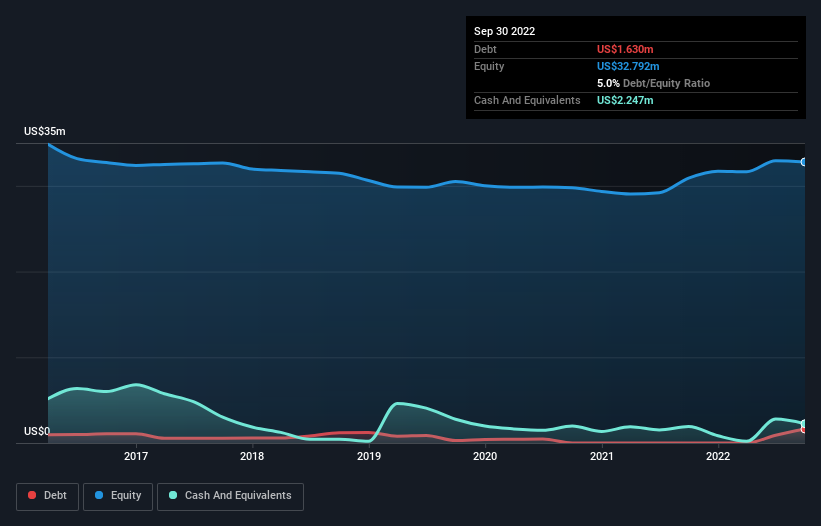Some say volatility, rather than debt, is the best way to think about risk as an investor, but Warren Buffett famously said that 'Volatility is far from synonymous with risk.' When we think about how risky a company is, we always like to look at its use of debt, since debt overload can lead to ruin. Importantly, Lion Copper and Gold Corp. (CVE:LEO) does carry debt. But the more important question is: how much risk is that debt creating?
When Is Debt A Problem?
Debt and other liabilities become risky for a business when it cannot easily fulfill those obligations, either with free cash flow or by raising capital at an attractive price. If things get really bad, the lenders can take control of the business. However, a more common (but still painful) scenario is that it has to raise new equity capital at a low price, thus permanently diluting shareholders. Having said that, the most common situation is where a company manages its debt reasonably well - and to its own advantage. The first thing to do when considering how much debt a business uses is to look at its cash and debt together.
Check out our latest analysis for Lion Copper and Gold
How Much Debt Does Lion Copper and Gold Carry?
You can click the graphic below for the historical numbers, but it shows that as of September 2022 Lion Copper and Gold had US$1.63m of debt, an increase on none, over one year. However, it does have US$2.25m in cash offsetting this, leading to net cash of US$617.0k.

A Look At Lion Copper and Gold's Liabilities
The latest balance sheet data shows that Lion Copper and Gold had liabilities of US$2.23m due within a year, and liabilities of US$1.63m falling due after that. Offsetting these obligations, it had cash of US$2.25m as well as receivables valued at US$4.0k due within 12 months. So it has liabilities totalling US$1.61m more than its cash and near-term receivables, combined.
Given Lion Copper and Gold has a market capitalization of US$24.9m, it's hard to believe these liabilities pose much threat. But there are sufficient liabilities that we would certainly recommend shareholders continue to monitor the balance sheet, going forward. Despite its noteworthy liabilities, Lion Copper and Gold boasts net cash, so it's fair to say it does not have a heavy debt load! When analysing debt levels, the balance sheet is the obvious place to start. But it is Lion Copper and Gold's earnings that will influence how the balance sheet holds up in the future. So if you're keen to discover more about its earnings, it might be worth checking out this graph of its long term earnings trend.
Since Lion Copper and Gold has no significant operating revenue, shareholders probably hope it will develop a valuable new mine before too long.
So How Risky Is Lion Copper and Gold?
By their very nature companies that are losing money are more risky than those with a long history of profitability. And in the last year Lion Copper and Gold had an earnings before interest and tax (EBIT) loss, truth be told. Indeed, in that time it burnt through US$7.9m of cash and made a loss of US$2.2m. Given it only has net cash of US$617.0k, the company may need to raise more capital if it doesn't reach break-even soon. Summing up, we're a little skeptical of this one, as it seems fairly risky in the absence of free cashflow. The balance sheet is clearly the area to focus on when you are analysing debt. However, not all investment risk resides within the balance sheet - far from it. To that end, you should learn about the 6 warning signs we've spotted with Lion Copper and Gold (including 3 which are a bit unpleasant) .
If, after all that, you're more interested in a fast growing company with a rock-solid balance sheet, then check out our list of net cash growth stocks without delay.
New: AI Stock Screener & Alerts
Our new AI Stock Screener scans the market every day to uncover opportunities.
• Dividend Powerhouses (3%+ Yield)
• Undervalued Small Caps with Insider Buying
• High growth Tech and AI Companies
Or build your own from over 50 metrics.
Have feedback on this article? Concerned about the content? Get in touch with us directly. Alternatively, email editorial-team (at) simplywallst.com.
This article by Simply Wall St is general in nature. We provide commentary based on historical data and analyst forecasts only using an unbiased methodology and our articles are not intended to be financial advice. It does not constitute a recommendation to buy or sell any stock, and does not take account of your objectives, or your financial situation. We aim to bring you long-term focused analysis driven by fundamental data. Note that our analysis may not factor in the latest price-sensitive company announcements or qualitative material. Simply Wall St has no position in any stocks mentioned.
About CNSX:LEO
Lion Copper and Gold
A mineral exploration company, engages in the acquisition, exploration, and development of copper projects in the United States.
Adequate balance sheet with slight risk.
Market Insights
Community Narratives


Recently Updated Narratives


Engineered for Stability. Positioned for Growth.


MINISO's fair value is projected at 26.69 with an anticipated PE ratio shift of 20x


Fiverr International will transform the freelance industry with AI-powered growth
Popular Narratives


MicroVision will explode future revenue by 380.37% with a vision towards success


NVDA: Expanding AI Demand Will Drive Major Data Center Investments Through 2026



